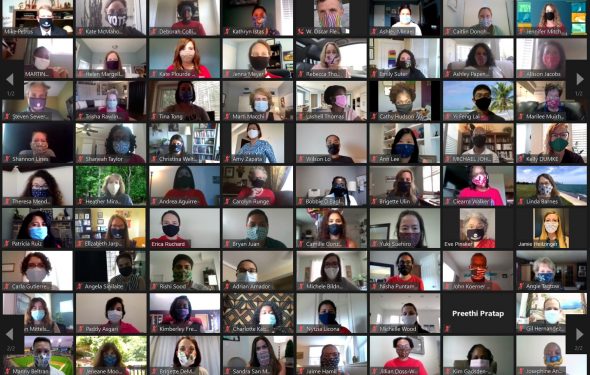Online learning experts offer tips for effective online teaching

As the COVID-19 epidemic pushed learning online at the University of Illinois Chicago, as well as at most university campuses across the country, instructors are grappling with how to quickly transform their face-to-face classes to an online learning format.
At UIC, the Doctor of Public Health in Leadership Program, or DrPH, which has served students online for a decade, has been serving an example of how to educate remotely. The UIC School of Public Health has a teaching and learning series to help faculty prepare for online learning, which helped faculty prepare over the summer for online learning this semester.
Several of the workshops were led by Christina Welter, program director and clinical assistant professor; Sophie Naji, academic coordinator, and Elizabeth Jarpe-Ratner, core faculty DrPH and clinical assistant professor; also leading sessions were Steve Seweryn, clinical assistant professor in epidemiology and biostatistics, and Mike Petros, clinical assistant professor in environmental and occupational health and safety.
Among the objectives of the presentations was to articulate the factors that influence effective distance-based education and demonstrate how the program applies these factors, making sure that a program’s pedagogical approach is paramount while shaping distance-based learning, and to provide teaching and technology tips for teaching programs.

Welter discussed the seminars that she and her partners gave to UIC faculty and staff.
UIC: What are some of the factors that influence quality and performance?
Welter: Online learning requires even more attention to increasing opportunities for dialogue and connection. Called social learning, helping students to feel comfortable with each other enough to share the application of course content is key. Interpersonal interaction between and among students is important. Moreover, how a course is designed is important as well as determining the instructor’s role in fostering the relationship between teacher and student, choosing the proper technology to help promote connection and engagement is key. Finally, of utmost importance, is conveying clear and explicit information multiple times helps everyone get on the same page.
UIC: What are some questions to consider before beginning to plan for online learning?
Welter:
- What are the overall learning goals of the program?
- What is the pedagogical approach that best matches the program goals and challenges?
- In what ways are these approaches integrated across the program and curriculum?
- How can the tools be used to facilitate learning outcomes?
UIC: What are the ways that the DrPH promotes engaged, quality learning in an online format?
Welter: The DrPH program also relies heavily on the application of the material in practice while working with a learning community. We often put students in communities or small groups to help build intimacy and trust within the group for sharing and reflecting on their experiences and application of course content. One way we facilitate this process is by using action learning. Action learning is: “… a coach-supported process involving a small group of people solving real problems… while at the same time focusing on what they are learning.. and how their learning can benefit each group member… and the organization or community as a whole,” Marquardt et al., 2009. Students work in virtual groups in which one student’s organization serves as the learning laboratory for the application of the course content to complete an applied project focus. Students utilize systematic reflection through journaling, memos, papers and presentations to critically think about course material to their experiences.
UIC: Can you give suggestions on how to organize the class?
Welter:
- Consider a flipped classroom setting where lectures are prerecorded and viewed in advance of class time to foster class discussion.
- Use the Blackboard discussion board to apply lecture content before or after discussion.
- Reflect Bloom’s taxonomy by organizing classes with a 30-minute lecture to help students build knowledge of the subject; between classes, set up questions in Blackboard to apply the content for skill-building; and then assign student leaders to facilitate group discussion to really apply learning to an activity.
- Engaged learning using learning groups as well as virtual breakout rooms with facilitated questions for discussion is another simpler way to promote engagement — it is vital that questions are shared in advance to promote students’ discussion. Use a “week at a glance” version of the syllabus to remind students where they are in the course.
UIC: Do you have any tips on how to plan for teaching and technology?
Welter: Plan, plan and plan. Organize Blackboard content logically with clear language that aligns with the syllabus, as well as the lecture titles and make sure to label connections. Send slides and handouts in advance of any class with clear instructions. Provide ppt templates and have questions for discussion read in advance. Prepare exercises in writing and send them to students in advance. Make sure to draw students’ attention to reading or other materials that will be important for group work.
UIC: Can you give any tips to improve engagement by students?
Welter: Use tools to help grab the attention of students and use polling but be sure to connect it to the content. While Blackboard allows videos shown through a shared screen it is not ideal, so have a link available but don’t dwell on the video. Use a shared screen to take real-time notes, which acts as a large post-it note. Use breakout groups to foster small group discussions where the instructor can check-in. Using Google Docs or other tools like the Padlet app can facilitate group work. In addition, using a chatbox and consider having a facilitator of the chat. Finally, debrief, reflect and offer class closure.
UIC: Can you give any tips to improve diversity and inclusion?
Welter: The first thing is to acknowledge diversity and promote inclusion and to remember that everyone learns, engages and communicates differently; and to build trust within and among the learning community. The instructor’s role is to provide a learning environment that encourages all types of students to participate best. Developing shared expectations and norms is one great way to be sure everyone is on the same page. Create a charter, group norms and agreements and/or expectations for dialogue and engagement to respect students. Conduct interpersonal exercises to raise awareness of different learning and communication styles. Encourage both verbal and written engagement and be patient. Try not to call out students but do ask for those who have not spoken. Give plenty of time and space for responses because 10 seconds can feel like 60 online. Finally, make video optional as not all students want to share their living spaces with the group.
UIC: Any final recommendations that you would like to leave us with?
Welter: Plan ahead for each class to help students prepare and be clear about what is happening and how to proceed. Communicate messages multiple times in multiple formats and modules to help ensure students are receiving the message. Setting expectations together helps students plan and prepare for their participation, engagement and responsibilities. Be open to considering different communication and learning styles to provide a more inclusive learning environment. Intentionally delivering information and helping students apply it to “real-world” situations will improve sustained learning.
